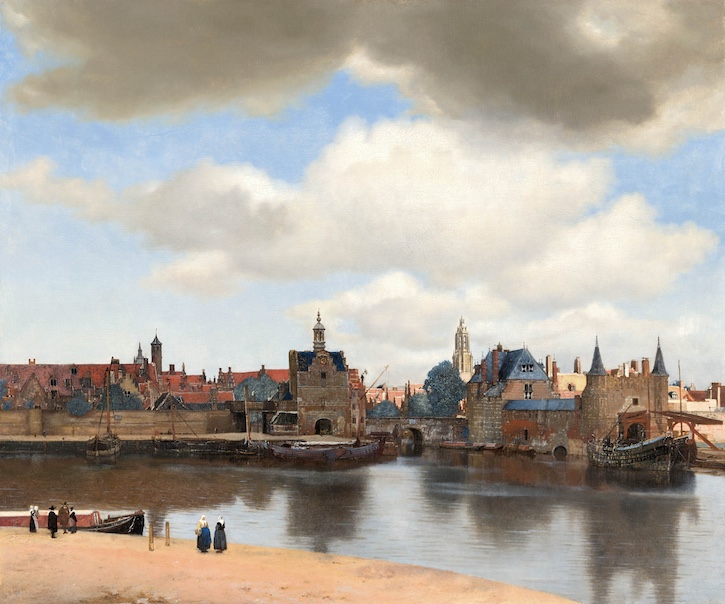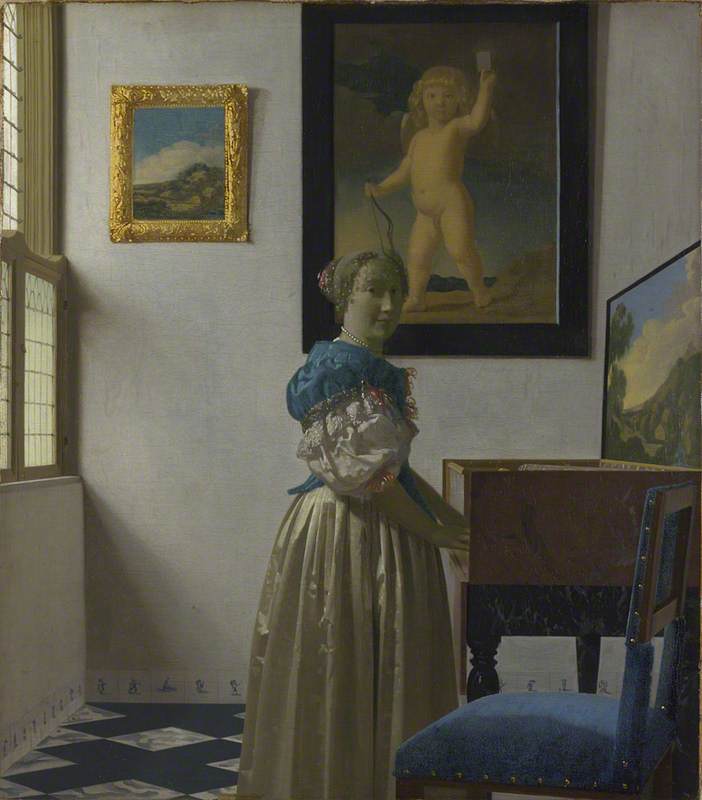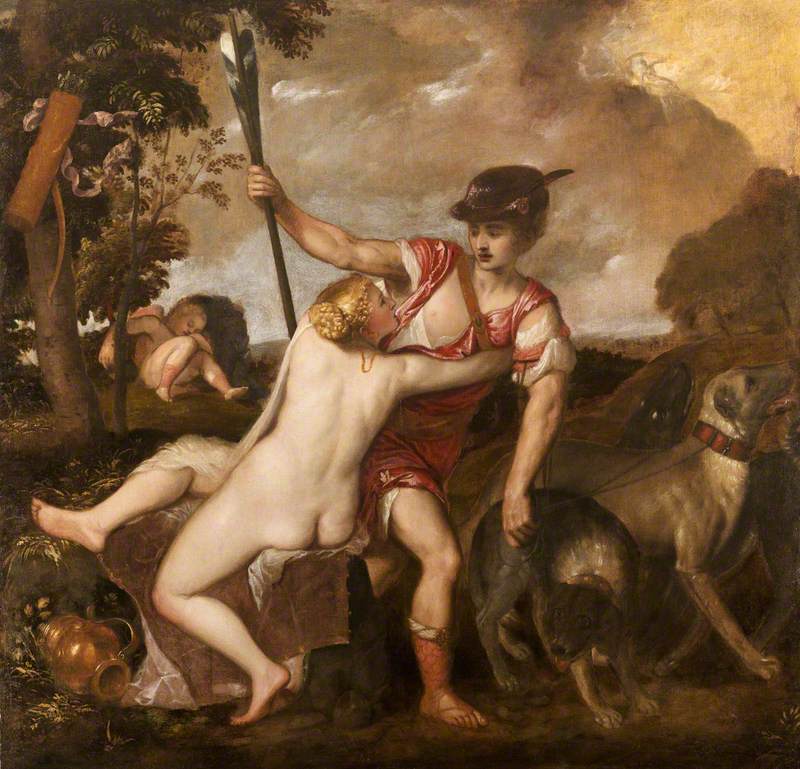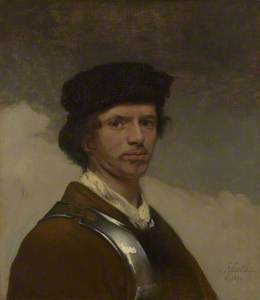A View of Delft (c.1660–1661) by the city's most famous artist, Johannes Vermeer (1632–1675), is a warm evocation of the small, walled city surrounded by the River Schie, intersected by streets and canals. One of two surviving townscapes of Delft by Vermeer, it captures the south-east aspect of the city flanked by the Schiedam and Rotterdam gates.
View of Delft
c.1660–1661, oil on canvas by Johannes Vermeer (1632–1675) 
The reflections on the still waters of the harbour known as De Kolk and the changing sky suggest something of the city's mixed fortunes. The dominant storm cloud casting a shadow over the city walls gives way to blue sky and sunlight, which bathes the city's prized Nieuwe Kerk (new church) and the buildings surrounding it.
Seventeenth-century Delft is a complex picture of growth, religious tolerance and misfortune. Delft's strong economy at the turn of the seventeenth century was sustained by its access to water, with textile manufacturing, brewing and maritime trade lining the pockets of the wealthy burghers who governed the city. The canal network allowed for close links with the royal court at The Hague, as well as larger urban centres such as Amsterdam, Dordrecht, Leiden and Rotterdam.
Yet, by mid-century, Delft's brewing and textile industries were shrinking and becoming less profitable, as the painter Jan Steen (1626–1679) discovered during his short residency in Delft leasing a brewery. Steen knew the self-important Burgomaster depicted in The Burgomaster of Delft and his Daughter (1655), an impressive portrait-cum-townscape, who acted as surety for the painter's debts.
The Burgomaster of Delft and his Daughter
1655, oil on canvas by Jan Steen (1626–1679) 
By the time Vermeer painted A View of Delft, Delft's population and economy were on the decline, worsened by blockades during the Anglo-Dutch naval war of 1652–1654 as well as health epidemics and sudden calamity. An accidental gunpowder explosion in 1654, prompted by an inspection of an underground arsenal north-east of the city, killed hundreds and maimed many more. Immortalised as 'The Delft Thunderclap' by writers (the sound of the explosion resonated 70 miles away), the immediate aftermath was captured by landscape painters such as Egbert van der Poel (1621–1661), who produced the scene several times.
A View of Delft after the Explosion (1654) shows people salvaging items and comforting one another. The ramshackle buildings and dead trees are offset against the solid outlines of Oude Kerk and Nieuwe Kerk, which appear unscathed.
A View of Delft after the Explosion of 1654
1654
Egbert Lievensz. van der Poel (1621–1664) 
The explosion caused structural damage to both churches, although the main tourist attraction in Delft, the tomb of William the Silent/Prince of Orange at Nieuwe Kerk, was undamaged. The explosion led to a national effort to rebuild much of the city and compensate victims. In the meantime, a number of painters left Delft (Der Poel left for Rotterdam in 1654 or 1655) and tragically, the talented Carel Fabritius (1622–1654), a pupil of Rembrandt van Rijn (1606–1669), died of his injuries after the blast at the age of 32. His studio was on a street adjacent to the arsenal.
A Young Man in a Fur Cap and a Cuirass (probably a Self Portrait)
1654
Carel Fabritius (1622–1654) 
Yet, in the period prior to and following the explosion, a number of artists were registered with the painters' and craftsmen's Guild of Saint Luke, and they made their mark on Delft. They shared an interest in light and linear perspective and found markets for scenes of tranquil domesticity as well as townscapes, churches and courtyards ordered by symmetry.
Church interiors
Three artists made a name for themselves depicting church interiors in Delft: Gerard Houckgeest (1600–1661), Hendrick Cornelisz. van Vliet (c.1611–1675) and Emanuel de Witte (1615–1617–1692). Born in The Hague, and the son of a court painter, Houckgeest moved to Delft in the 1630s and was a member of the Delft Guild in 1639. By 1651, he had moved to Steenbergen, but while in Delft he produced a number of paintings of the interiors of the Oude Kerk and Nieuwe Kerk. His Interior of the Nieuwe Kerk, Delft, with the Tomb of William the Silent (1650) is thought to be his most influential work.
Interior of the Nieuwe Kerk, Delft, with the Tomb of William the Silent
1650, oil on oak panel by Gerard Houckgeest (1600–1661) 
Houckgeest set a high standard for clarity, light and perspective, capturing the subtle markings of the imposing stone columns. The arch and the black and white tiles are imaginary, the arch acting as a frame within a frame, and the tiles complementing the colour scheme of the tomb. A beam of sunlight illuminates the pamphlet or book read by a couple of men kneeling on the floor. Interestingly, Houckgeest focused not on the two effigies of William the Silent, who resided in Delft in the last years of his life, but on a golden statue of Liberty. The statue would have spoken to Dutch viewers in the wake of the Peace of Munster of 1648, which marked an end to the Eighty Years' War with Spain.
Emanuel de Witte stayed in Delft for the best part of a decade, joining the Guild of Saint Luke in 1642 and leaving for Amsterdam in around 1652. While in Delft, he painted a number of church interiors – inspiration for his later work in Amsterdam. His work was similar to Houckgeest's in terms of his ability to depict the grand features of the Oude Kerk and Nieuwe Kerk and his use of framing devices, such as the arch, but he excelled in adding warmth and colour to the lofty spaces, showing men and women, young and old, and on more than one occasion, a dog urinating against the pillar or floor of the church.
Hendrick Cornelisz. van Vliet was a native of Delft and joined the Guild in 1632. He worked predominantly on portrait commissions and later moved on to church interiors. He borrowed motifs from Houckgeest and De Witte, with all three adopting the illusionary, theatrical device of a green curtain. A number of his paintings show a freshly dug tomb, as in Interior of the New Church at Delft (1667). It is likely that these interiors were painted for wealthy relations of the deceased.
Interior of the New Church at Delft, with the Tomb of William the Silent
1667
Hendrick Cornelisz. van Vliet (c.1611–1675) 
Genre paintings: scenes of everyday life
The death of William II, Prince of Orange, in 1650, left a power vacuum and there was a lull in royal commissions for history paintings and portraiture, affecting Delft painters such as Leonard Bramer (1596–1674) and Fabritius. Bramer had built a reputation at court for his Italian-inspired Biblical scenes and wall murals.
From the 1650s onwards, artists in Delft specialised increasingly in townscapes and scenes of contemporary life, in accordance with regional trends. These paintings travelled well, and were purchased by collectors in other cities. Delft genre paintings ranged from guardroom and drinking scenes by artists such as Anthonie Palamedesz. (1601–1673), to domestic interiors and townscapes.
Merry Company (Interior with Cavaliers and Ladies)
1630s
Anthonie Palamedesz. (1601–1673) 
In his diminutive townscape A View of Delft, with a Musical Instrument Seller's Stall (1652), Fabritius packs a lot in, dramatically foreshortening the musical instruments and arching steeply the bridge over the Oude Langendijk canal. It is likely that this work was originally intended for a viewing box, popular with Dutch artists at the time, and mounted onto a curve. The painting juxtaposes worldly values (the instruments and tavern) with religious values (the Nieuwe Kerk), which is reminiscent of De Witte's church interiors.
A View of Delft, with a Musical Instrument Seller's Stall
1652
Carel Fabritius (1622–1654) 
Perhaps the most striking paintings were those focusing on the domestic sphere, most famously Vermeer’s refined scenes of wealthy young women, as well as Pieter de Hooch's (1629–1684) dignified scenes of maidservants and mothers in more modest apparel and settings. Like Fabritius and the church painters, Vermeer and De Hooch shared an interest in linear perspective, optical illusions and the play of light on surfaces.
Interior with a Woman Knitting, a Serving Woman and a Child
Pieter de Hooch (1629–1684) 
De Hooch was born to a builder and a midwife in Rotterdam, and moved to Delft in 1652, where he remained until 1661. After he married in 1654, he focused on courtyard scenes and interiors featuring women and children. His hallmark device was the doorkijkje, the see-through door, which added depth to the picture and pointed to a world beyond the courtyard or room he was depicting.
In A Woman and her Maid in a Courtyard (c.1660/1661), De Hooch renders in detail the patterns and textures of Delft brickwork, and signals the workings of a well-run home: the clean, sparse surfaces; the broom leaning against the wall; a demure maid receiving instruction from her mistress.
A Woman and her Maid in a Courtyard
about 1660/1
Pieter de Hooch (1629–1684) 
In The Courtyard of a House in Delft (1658), a maid is accompanied by a willing child on household duties. De Hooch's paintings provide a snapshot of the lives of women at work, although it was an idealistic view based on values promoted in contemporary treatises on household management. Jacob Cats' book Houwelyck (1625) was in wide circulation by the mid-century, and promoted domestic order and a morally tidy home as the foundation of Dutch prosperity.
While De Hooch's women and children are shown on duty and kept at a decorous distance, Vermeer's main body of work is of women at leisure and in lavish interiors, some of which are startlingly intimate. Born in Delft to an art dealer, Vermeer married well and enjoyed the patronage of a few wealthy Delft patrons, most notably Pieter van Ruijven and his wife Maria Simonsdr de Knuijt. Some women are shown unguarded and others address the viewer directly.
In A Young Woman standing at a Virginal (c.1670–1672), Vermeer succeeds in making the young lady the subject of the painting while demarking the light and space with a characteristic side window, chair in the foreground and paintings within the painting.
A Young Woman standing at a Virginal
about 1670-2
Johannes Vermeer (1632–1675) 
Vermeer's domestic spaces are rich in tone, colour and texture, often contrasting light and shade strongly using the technique of chiaroscuro, as seen in The Guitar Player (c.1672).
Did a Delft 'school' exist, in terms of a network of local painters who collaborated? To some extent, yes, but the exodus of artists from Delft, except a comfortable few like Vermeer, meant it was short-lived. What united painters who were members of the Guild of Saint Luke in and around the 1650s (with the notable exception of Bramer) was a tendency to present orderly, bright and calm perspectives of Delft, and a dignified view of its inhabitants. This was especially the case after 1654, with art providing a sense of equilibrium to a shattered city.
Rachel Bates, freelance writer
This content was funded by the Samuel H. Kress Foundation































